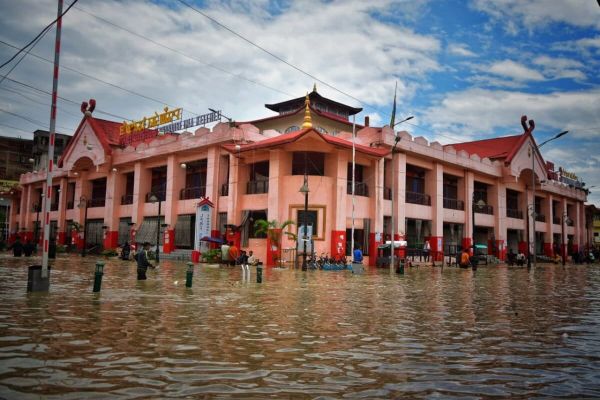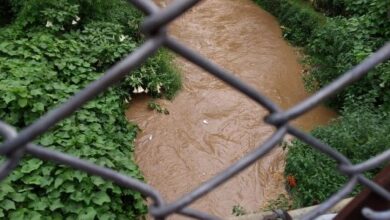Human activities, climate pressures worsen Manipur flood situation
Recurring floods in Manipur, including the recent one in September, have inundated villages, farms and houses

On the afternoon of September 14, four gates of the Mapithel dam in Manipur were suddenly opened, leading to flooding in the downstream villages across the Thoubal river basin. The sudden release of water inundated paddy fields, fish farms, and households, sweeping away two elderly persons who later died.
The president of the Manipur Congress and an elected representative of the Manipur Legislative Assembly, Keisham Meghachandra, accused the Water Resource Department (WRD) for creating a “man-made disaster” and noted that there was no proper communication between the government institutes and the people residing downstream. But the clarification issued by the WRD signals that the discharge was mandatory in light of the “extraordinary natural inflow” rather than dam operation and that adequate “mobile communication” was completed by field staff to communities downstream.
In recent years, Manipur has seen recurring floods. Floods in 2024 caused due to the western bank breach of the Imphal river affected around 200,000 people, and over 24,000 houses were damaged in 348 villages and urban localities. Despite it being one of the worst floods witnessed in its recent history, Manipur did not make the cut for the flood assistance package announced by the central government budget last year. Another flood in June 2025 impacted 1,64,879 people, damaging 35,342 houses across 643 localities, according to official reports. Due to multiple breaches across the Imphal, Kongba and Iril rivers, almost 4,000 people were evacuated and shifted to safer places and 77 temporary relief camps opened for the displaced. A sum of ₹29.20 crores for Manipur was approved on July 10, 2025 by the Ministry of Home Affairs to be allocated to the State Disaster Response Fund.
Three months later, in September, another fresh wave of floods inundated and displaced houses across the Thoubal and Iril river basins. The estimate of the damage is yet to be disclosed, but the damage is most likely proportional to the earlier floods, albeit more widespread across previously unaffected locations, the local residents say.
When it rains, it pours
Manipur, geographically, is drained by an array of north to south flowing rivers and streams originating from the surrounding hills. Of the two river systems, the Manipur river system crisscrosses across the Imphal valley and drains out through Myanmar whilst the Barak river system runs to Bangladesh. An increase in rainfall in the hills leads to a sudden increase in the load of the rivers within a few hours.
Brajakumar Tourangbam, Director, Directorate of Environment and Climate Change, Government of Manipur, while explaining how floods occur post rainfall remarks, “Due to the very sudden increase in water load in the upper basin, all the rivers started filling up and multiple breaches (breaking of a protective barrier) occur here and there.” Similarly, due to sudden increase in the load of Iril, Thoubal, Wangjing, Arong and Kongba rivers, multiple breaches happened and flooded a major part of the southeastern portion of Imphal valley.
However, a small outlier was the flooding in parts of Lamlai constituency, the largest rice producing constituency which is less susceptible to floods. Water from Iril entered the small stream locally known as Itam and as it overflowed many villages were flooded.
“If you look at the rainfall data inter-annually, there isn’t much change but once you look closer into the intra-annual pattern, then you will realise where the problem is,” says Indrakumar Laishram, research scholar at Centre for Study of Regional Development, Jawaharlal Nehru University. He focuses on mapping vulnerability assessment and risk reduction of floods in Imphal, Manipur. For three days straight in September — 13, 14 and 15 — large parts of Manipur witnessed abnormal intense rainfall across the hills and valley. According to the data provided by the India Meteorological Department (IMD), Senapati, Ukhrul, Thoubal and Imphal East started receiving “large excess” rainfall from September 13 onwards till the next three days. On September 14, intense rainfall poured over Thoubal (621% above normal), Senapati (2,130% above normal), Ukhrul (1,348% above normal) and Imphal East (1,114 % above normal).
“What is happening with rainfall is that we are having huge anomalies wherein the earlier distribution is disturbed, and we have longer spells of dry days and then suddenly a very “intensive” rainfall starts,” Tourangbam adds.
Recurring floods and the need for coordination
The agrarian sector which occupies the largest share in the state’s economy is one of the worst impacted. With large populations impacted by major floods earlier this year and the previous year, the extent of loss and damage is only compounding. The largest public hospital — Jawaharlal Nehru Institute of Medical Sciences (JNIMS) had to be evacuated twice this year and remain shut for days due to the flood.
Nongmaithem Khelchandra, 50 of Thambalkhong had to be evacuated again for the third time due to the breach in Iril river. “June 2024, June 2025 and now in September 2025, our house went five feet under water and we have lost everything,” laments Khelchandra whilst cleaning the leftover mud inside their dilapidated house. “We have only received 2 kg of rice from the government in the span of three devastating floods,” he adds, signalling a major rehabilitation support gap.
The sudden recurring floods, says Laishram, exposes systematic neglect and failure and can be attributed to other factors such as the “increasing deforestation in the upper basins thereby increasing surface runoff, decreasing buffer zones due to urbanisation and encroachment, lack of proper early warning system, faulty flood plain zonation, etc.” he explains. Invasive vegetation such as para grass (Urochloa mutica) outgrowths and bottlenecks by plastic pollutants and debris constricts flow of the rivers and streams; thereby decreasing the drainage of storm water, he adds.
“We understand that climate change is accelerating damage across, but our institutions are not working in tandem to decrease the impacts of it. For example, the opening of the dam gates was entirely by the WRD; without taking discussing with the Governor, agriculture departments, state disaster relief force, etc.” remarks Meghachandra, who has been raising the need to fix accountability and compensate for the livelihoods lost.
Meanwhile, the High Court of Manipur has taken cognisance of the increasing successive floods and landslides occurring every year and filed a suo-motu Public Interest Litigation (PIL). The PIL seeks to review and hold accountability to the systematic neglect of the State of Manipur and 40 other respondents. The next hearing for this case is on October 3.
(The article was first published in Mongabay India)




